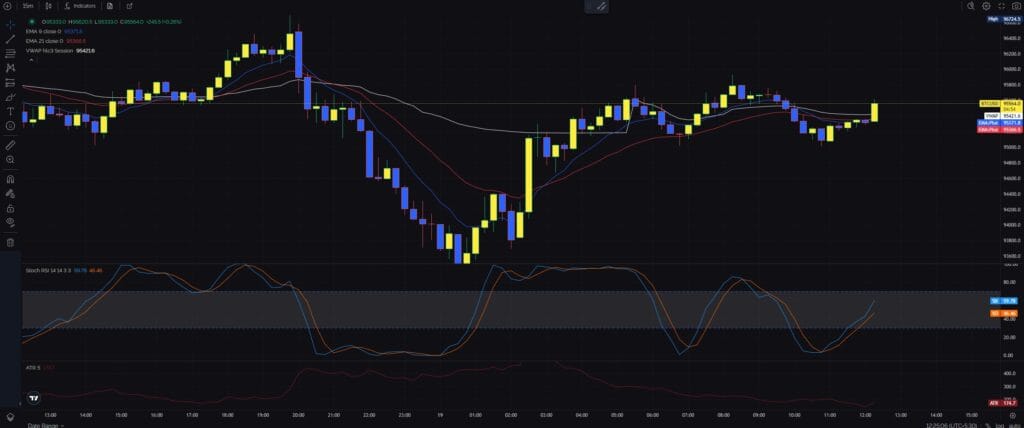Scalping is a high-frequency trading strategy that aims to capture small price movements in highly liquid markets. This guide will provide an in-depth look into the best scalping strategy using 1-minute and 5-minute charts, including market selection, indicator setup, entry and exit rules, risk management, and psychological discipline. This comprehensive SEO-friendly article ensures traders can find valuable insights through search engines, improving their trading performance and efficiency.
What is Scalping in Trading?
Scalping is a short-term trading technique where traders aim to make profits from small price fluctuations. This method requires rapid decision-making and strict risk management. Unlike swing trading, where positions are held for days or weeks, scalpers typically execute multiple trades within minutes.
Scalping Trading : 9 and 15 EMA Strategy
Key Benefits of Scalping
- Quick profits with minimal exposure to market risks.
- Less dependency on long-term market trends.
- Opportunities available in all market conditions.
- High liquidity ensures smooth trade execution.
Step 1: Choosing the Right Market
1.1 Markets Best Suited for Scalping
Scalping requires highly liquid and volatile markets to ensure quick execution and minimal slippage. The best markets for scalping include:
- Forex: Major currency pairs such as EUR/USD, GBP/USD, USD/JPY have high liquidity and low spreads.
- Cryptocurrency: Bitcoin (BTC/USD), Ethereum (ETH/USD), and other high-volume crypto pairs.
- Stocks: Large-cap stocks and indices such as the S&P 500, NASDAQ, and Dow Jones.
1.2 Best Trading Hours for Scalping
To maximize opportunities, scalp during peak volatility hours:
- Forex: London Session (3 AM – 12 PM EST) and New York Session (8 AM – 5 PM EST)
- Stocks: First and last hour of the trading session (9:30 AM – 10:30 AM EST and 3:00 PM – 4:00 PM EST)
- Crypto: Higher volatility periods such as major news releases or market openings.
Step 2: Indicator Setup
A combination of leading and lagging indicators ensures a robust strategy. The following indicators are essential:
Online Trading for Beginners: How to Get Started and Succeed
2.1 VWAP (Volume Weighted Average Price)
VWAP helps identify ideal entry points by showing the average price based on volume.
- Above VWAP: Indicates a bullish trend.
- Below VWAP: Indicates a bearish trend.
2.2 Exponential Moving Averages (EMA 9 & EMA 21)
These moving averages confirm trend direction and momentum:
- Bullish Trend: EMA 9 crosses above EMA 21.
- Bearish Trend: EMA 9 crosses below EMA 21.
2.3 Stochastic RSI (14, 3, 3)
This momentum indicator helps identify overbought and oversold conditions:
- Below 30: Indicates oversold conditions (potential buy signal).
- Above 70: Indicates overbought conditions (potential sell signal).
MACD Explained: Basics & Best Settings
2.4 Average True Range (ATR)
ATR measures market volatility and helps set stop-loss and take-profit levels.
Step 3: Entry & Exit Rules
A systematic entry and exit approach minimizes risk and maximizes profits.
3.1 Long (Buy) Entry Conditions
- Price above VWAP (bullish trend confirmation).
- EMA 9 crosses above EMA 21 (strong bullish momentum).
- Stochastic RSI below 30 (oversold signal).
- Entry Trigger: Confirmation candle with increased volume.
3.2 Short (Sell) Entry Conditions
- Price below VWAP (bearish trend confirmation).
- EMA 9 crosses below EMA 21 (strong bearish momentum).
- Stochastic RSI above 70 (overbought signal).
- Entry Trigger: Confirmation candle with increased volume.
3.3 Exit Rules
- Stop-Loss: Place stop-loss at 2x ATR below/above the entry point.
- Take-Profit: Target 1.5x to 2x ATR for a 1:1.5 or 1:2 risk-reward ratio.
Step 4: Risk Management (Most Important)
Risk management is crucial in scalping due to the rapid nature of trades.
Cup and Handle Pattern: A Proven Strategy for Bullish Markets
4.1 Position Sizing
- Never risk more than 1-2% of total capital per trade.
- Adjust position size based on ATR and stop-loss distance.
4.2 Stop-Loss Strategy
- Use hard stop-losses to prevent emotional trading.
- Set stop-loss at 2x ATR to accommodate market volatility.
4.3 Take-Profit Strategy
- Aim for a 1:1.5 or 1:2 risk-reward ratio.
- Use trailing stops to maximize profits during strong trends.
Step 5: Psychology & Discipline
Scalping requires strong discipline and a focused mindset.
5.1 Avoid Overtrading
- Stick to 3-5 high-quality trades per session.
- Avoid revenge trading after a loss.
5.2 Follow the Trading Plan
- Do not deviate from pre-defined entry and exit rules.
- Keep emotions out of trading decisions.
5.3 Backtesting & Strategy Refinement
- Backtest the strategy on historical data before going live.
- Adjust parameters based on performance metrics.
Bonus Tip: Choosing the Right Broker & Platform
- Use a low-spread, fast-execution broker.
- Platforms like TradingView, MetaTrader 4/5, or NinjaTrader offer superior charting and execution.
This best scalping strategy is designed to maximize efficiency while minimizing risk. By following the steps outlined, traders can capitalize on short-term market movements effectively. The key to success lies in strict risk management, disciplined execution, and continuous refinement of the strategy.


2 Comments
Pingback: Best Crypto to Buy Right Now (2025) – Coins Set to Explode - Trade Maximize
hi